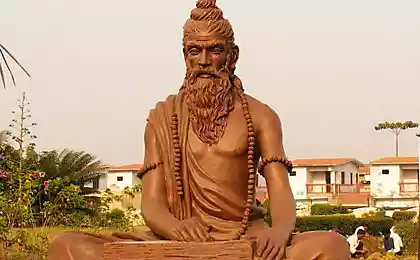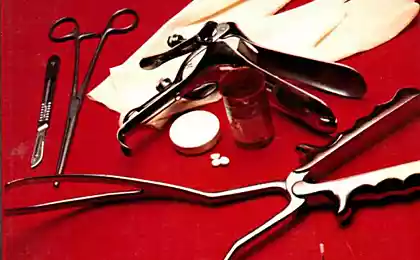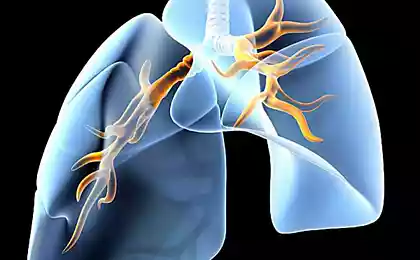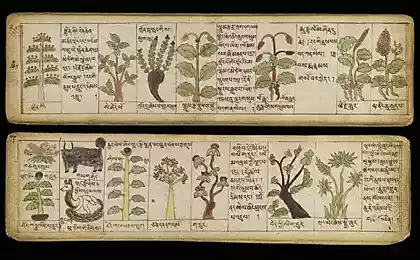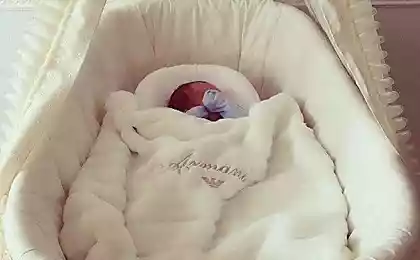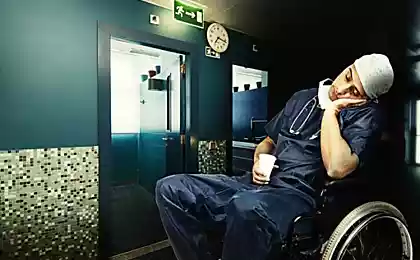1221
Facts about anesthesia
Anesthesia - artificially induced state of reversible inhibition of the central nervous system, in which there is sleep, muscle relaxation, and most importantly a complete lack of pain sensation. Today you will find 10 interesting facts about anesthesia.
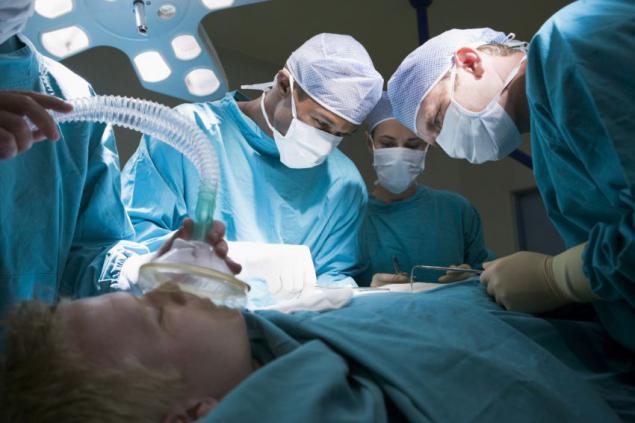
Comedians called anesthesia means by which the doctor gets rid of the tips of the patient during surgery.
If you stop joking, you have to admit anesthesia general anesthesia, a kind of state of artificial sleep with complete or partial loss of consciousness and loss of pain sensitivity. It is, in fact, it is clear to anyone who knows Greek: anesthesia in the Greek language "numb" or "numb." Experts still advise not to be confused with anesthesia anesthesia. It - also a Greek word and it means "insensitivity." Distinguish anesthesia anesthesia easy: anesthesia involves not only local anesthesia, but the shutdown of consciousness.
In the cabin, the ship's doctor of the English galleon "Mary Rose", which sank in 1545, found a lot of flasks, pots, bottles of medicine, as well as a large wooden mallet. Here is the hammer and designed for anesthesia - it is switched off and consciousness.
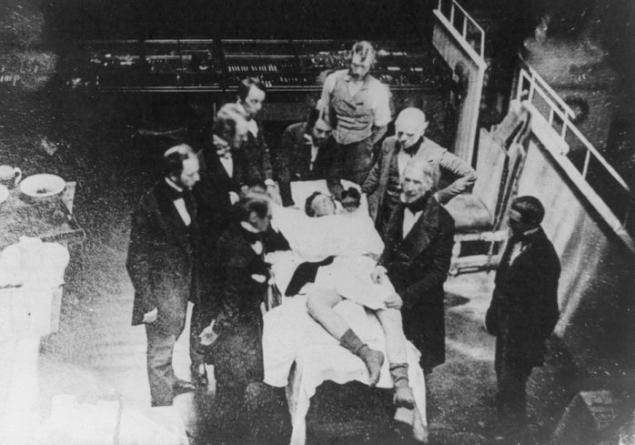
Even before the hammer inhumane humanity may enjoy the carotid infusions of herbs - the opium poppy, hemp, henbane, hemlock, poison hemlock. Sometimes the same infusion of herbs soaked sponge and set on fire. Inhalation Causes of patients - the main thing that is not a doctor.
By the middle of the XIX century gave way to the position of the hammer chemistry. We discovered a substance that allows you to disable the consciousness and make surgery without pain. One of the first - as it happens - they took advantage of dentists.
December 11, 1844 for the first time removed a tooth with anesthesia. As usual, it happened almost by accident. The night before, a resident of the town of Hartford in Connecticut dentist Horace Wells wandered into the session demonstrate the effect of nitrous oxide, which conducted a Barnstormer Gardner Colton. Demonstration impressed dentist: in the morning he came to the hotel for a visiting lecturer and invited him to try out the effect of "laughing gas" for patients who will remove the tooth. In the absence of other volunteers, the experience he decided to put on yourself. Everything went like clockwork: anesthesia acted and colleague, Dr. Riggs Wells removed completely healthy tooth. "A new era in the removal of teeth!" - Enthusiastically exclaimed to escape the burden of the tooth without the dentist and nitrous oxide introduced into medical practice.
Then we do not know what security nitrous oxide mix with oxygen, so that one of these deletions almost ended tragically.
Another dentist, Dr. William Morton, a dentist and a surgeon from Boston found that test subjects can easily tolerate the painful operation if they are to give it a breath of ether. October 16, 1846 decided to Morton and colleagues demonstrated ether anesthesia in action. Colleagues were delighted and expressed their intention to apply the air in daily practice.
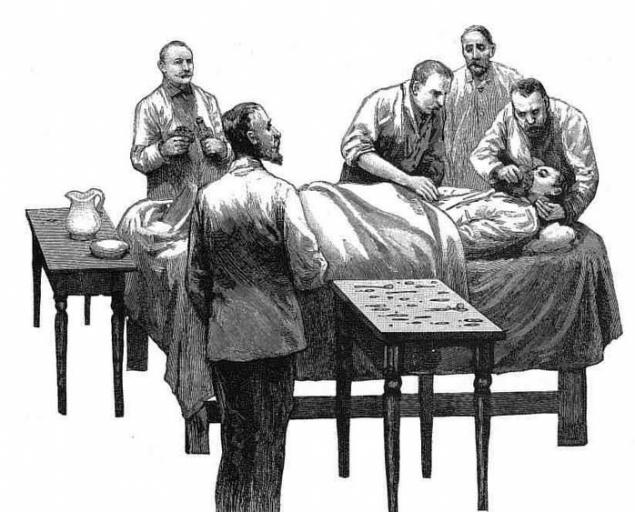
In less than 10 years of famous Russian surgeon Nikolai Pirogov, giving anesthesia in the field, in the English and the French besieged Sevastopol.
A year later than Morton, Scottish obstetrician James Simpson, the first to use anesthesia during childbirth. Later, when he saw the photo adult Wilhelmina Karstayrs Dr. Simpson said, "Oh, Holy Anesthesia!»
At the beginning of the XIX century Japanese poet and surgeon Seishi Hanaoka studied the possibility of using the anesthetic mixture of six different alkaloids. Wife and mother of researchers have offered to become a "guinea pigs." The surgeon chose his wife, and explained it simply and clearly: "My mother had one person».

Source: l-afinogentov.livejournal.com

Comedians called anesthesia means by which the doctor gets rid of the tips of the patient during surgery.
If you stop joking, you have to admit anesthesia general anesthesia, a kind of state of artificial sleep with complete or partial loss of consciousness and loss of pain sensitivity. It is, in fact, it is clear to anyone who knows Greek: anesthesia in the Greek language "numb" or "numb." Experts still advise not to be confused with anesthesia anesthesia. It - also a Greek word and it means "insensitivity." Distinguish anesthesia anesthesia easy: anesthesia involves not only local anesthesia, but the shutdown of consciousness.
In the cabin, the ship's doctor of the English galleon "Mary Rose", which sank in 1545, found a lot of flasks, pots, bottles of medicine, as well as a large wooden mallet. Here is the hammer and designed for anesthesia - it is switched off and consciousness.

Even before the hammer inhumane humanity may enjoy the carotid infusions of herbs - the opium poppy, hemp, henbane, hemlock, poison hemlock. Sometimes the same infusion of herbs soaked sponge and set on fire. Inhalation Causes of patients - the main thing that is not a doctor.
By the middle of the XIX century gave way to the position of the hammer chemistry. We discovered a substance that allows you to disable the consciousness and make surgery without pain. One of the first - as it happens - they took advantage of dentists.
December 11, 1844 for the first time removed a tooth with anesthesia. As usual, it happened almost by accident. The night before, a resident of the town of Hartford in Connecticut dentist Horace Wells wandered into the session demonstrate the effect of nitrous oxide, which conducted a Barnstormer Gardner Colton. Demonstration impressed dentist: in the morning he came to the hotel for a visiting lecturer and invited him to try out the effect of "laughing gas" for patients who will remove the tooth. In the absence of other volunteers, the experience he decided to put on yourself. Everything went like clockwork: anesthesia acted and colleague, Dr. Riggs Wells removed completely healthy tooth. "A new era in the removal of teeth!" - Enthusiastically exclaimed to escape the burden of the tooth without the dentist and nitrous oxide introduced into medical practice.
Then we do not know what security nitrous oxide mix with oxygen, so that one of these deletions almost ended tragically.
Another dentist, Dr. William Morton, a dentist and a surgeon from Boston found that test subjects can easily tolerate the painful operation if they are to give it a breath of ether. October 16, 1846 decided to Morton and colleagues demonstrated ether anesthesia in action. Colleagues were delighted and expressed their intention to apply the air in daily practice.

In less than 10 years of famous Russian surgeon Nikolai Pirogov, giving anesthesia in the field, in the English and the French besieged Sevastopol.
A year later than Morton, Scottish obstetrician James Simpson, the first to use anesthesia during childbirth. Later, when he saw the photo adult Wilhelmina Karstayrs Dr. Simpson said, "Oh, Holy Anesthesia!»
At the beginning of the XIX century Japanese poet and surgeon Seishi Hanaoka studied the possibility of using the anesthetic mixture of six different alkaloids. Wife and mother of researchers have offered to become a "guinea pigs." The surgeon chose his wife, and explained it simply and clearly: "My mother had one person».

Source: l-afinogentov.livejournal.com





